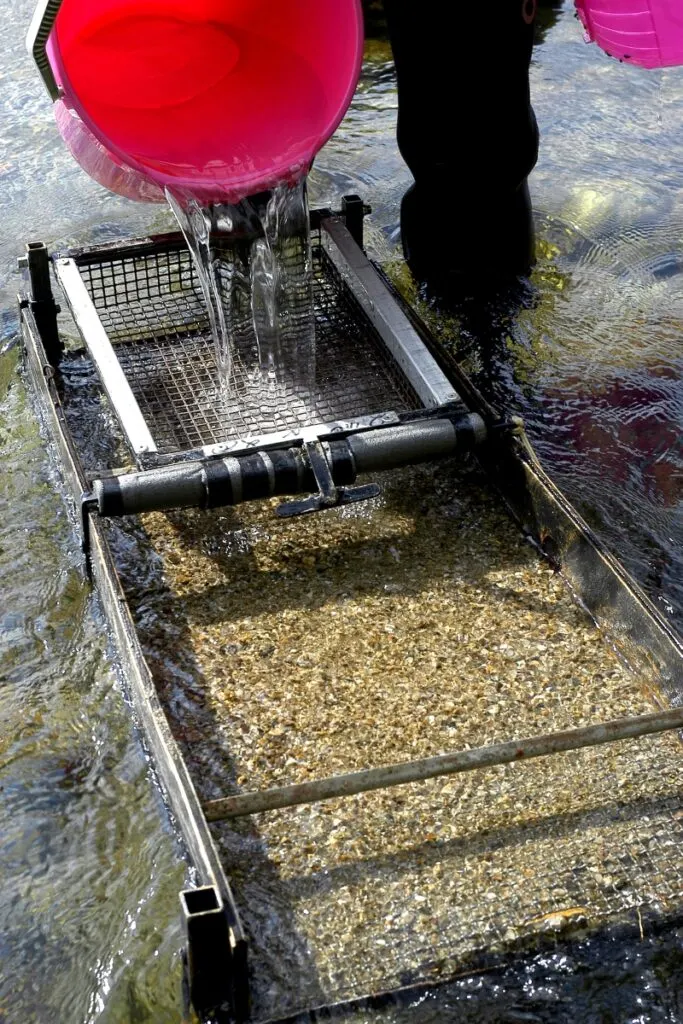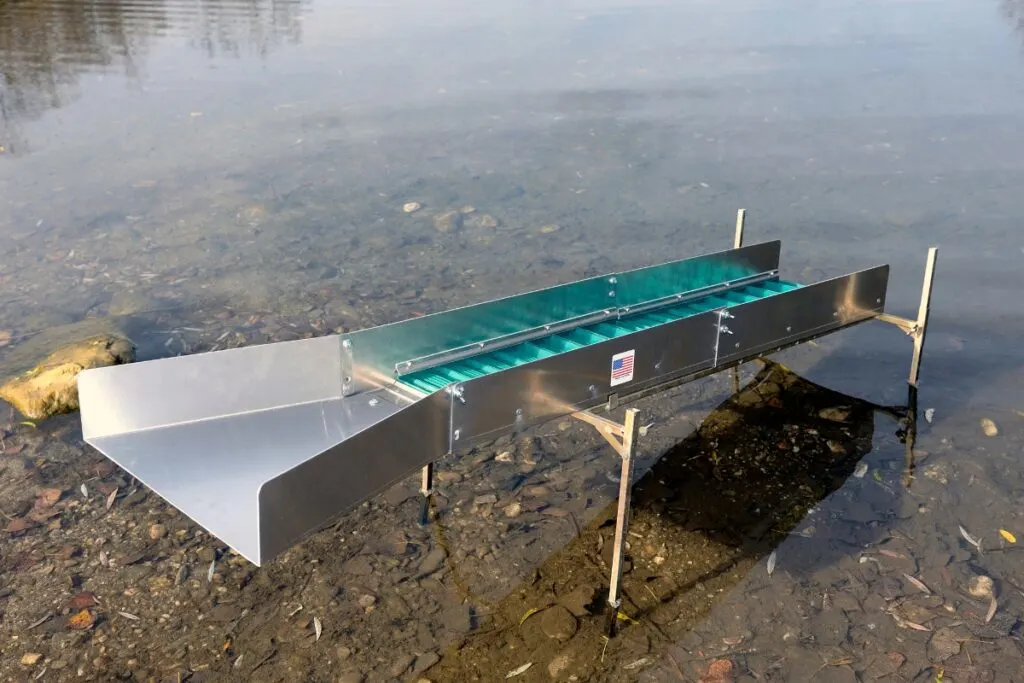As an Amazon Associate, I earn from qualifying purchases with no additional costs for you.
Extraction of gold from deposits was previously accomplished using manual separation techniques such as gold panning. As a result, large enterprises conducted most mining activity in the 20th and 21st centuries, utilizing large-scale equipment. However, due to the price of gold, millions of prospect miners are working on small scales across the country using sluice boxes again to strike it rich.
The gold sluice box is a time-saving alternative to the traditional panning for gold because it enables the prospector to sort through a significantly greater quantity of sediment efficiently. A sluice box also referred to as a gold chute, is one of the most dependable methods for separating gold.
In addition, a sluice box is one of the most common and dependable pieces of equipment used to recover gold. As a result, it has a significant presence in the gold mining industry, both great and small. Below we will look into the best ways to use a sluice box properly.

If you are interested in checking out the best sluice box for gold panning you can find it by clicking here (Amazon link).
How Does A Gold Sluice Box Work
Most metal gold sluice boxes are lightweight and feature a riffle tray that you can easily remove. The term “sluice box” refers to a piece of equipment with baffles or riffles running down the bottom edge of its most significant side.
The carpet gets laid below the riffle tray in the sluice box in the hopes that it will capture any flecks of gold that may be present. In addition, the angle at which it sits in the stream will allow the natural current to wash the particles through the box.
The rocks’ size and shape, the sand’s volume and composition, the style of the riffle, and the depth of the water flow are just a few of the variables that affect the slope or grade of a sluice.
Each situation calls for a different sluice gradient, which can be optimized through trial and error by starting with an angle of about 1 inch for every foot of length.
They are either placed along the course of a river or stream or have water pumped into them so the water velocity can be more effectively managed without washing out already collected gold from the bottom.
As the material collected from the streambed moves through the main body of the sluice box, the riffles cause gold particles denser than the other materials to fall through the mesh screen and unto the sluice box mat below.
Once they have reached the bottom of the sluice box, the gold particles can be collected and stored safely.
When it is time to empty your sluice box and retrieve the gold, you will need to remove the riffle tray from the bucket and clean the carpet. Afterward, the material will be placed in a bucket to get panned later.
How Do You Set Up A Gold Sluice Box
Like gold panning, choosing an excellent place to work the sluice box is the first step in using one. First, pinpoint a location close to the gravel you plan to deal with in the stream. Next, you’ll need a place to dump the sediment so it can work its way through the sluice box.
The slope angle and water flow over the sluice should get altered to allow the gravel, including larger cobbles, to continue flowing over the various baffles and riffles in the box.
The standard slope you want for your sluice box is about a 1-inch drop for every foot of sluice. So, for example, if you have a 3-foot sluice box, then you want your sluice box at a 3-inch slope.
TIP: You need to know something about how gold deposits occur to understand which rocks to look for when prospecting. Find out the answer in the article below:
5 Rocks You Need To Look For When Gold Prospecting (+ Why)
How To Use A Sluice Box For Gold

Now that the gold sluice box has been installed and the water is moving through it without obstructions, it is time to add the gravel. Transfer the stone and dirt directly to the sluice box’s front end using a scoop or shovel.
Be careful not to pour too much gravel into the container, as doing so may result in losing gold. Instead, add the stone and sand in a quick enough manner such that you are always able to see the tops of the riffles.
Whenever you notice a sizeable accumulation of black sand on the riffles inside the sluice box, it is time to clear the gold out of the box and remove it.
It is recommended that the sluice box be elevated above the water. Utilizing the sluice, transfer the black sand to the bucket at your disposal. You presently have a bucket full of concentrates in your possession. Get a gold pan, and begin separating the gold from the concentrates.
What Angle For Gold Sluice Box
When constructing a sluice, it is essential to employ the appropriate angle. Because the slope is generally between 5 and 7 degrees, it is simple for most spherical rocks and pebbles to navigate their way through. However, you want the sluice to go through at a slower, more random pace rather than flow too quickly.
TIP: Metal detectors can be another helpful tool when gold prospecting. Check out how to use metal detectors properly in the article below:
How to Actually Find Gems with a Metal Detector? It’s Easy!
Using Sluice Box For Gold Tips & Tricks
Invest some time in emptying the exit of the sluice box of any large pebbles or other things that might collect there and cause it to become clogged. Not removing these larger rocks and other items could cut off the water flow and extract the gold from the riffles.
When there is an accumulation of black sand in the sluice box, it is vital to clean it out; however, you must be careful not to lose any of the black sand still in the sluice. The black sand may contain gold.
What Is The Best Sluice Box For Gold
You can choose from a few sluice boxes, and here are a few you can look at.
- Stansport Aluminum Sluice Box
The hardware of the Stansport Aluminum Sluice Box (Amazon link) is made of zinc and aluminum, which provides the box with strength and ensures that its performance is long-lasting. Gravity and water flow are two of the most effective methods for finding gold.
The 24” Compact Sluice Box is ideal for quick and thorough sifting and efficiently concentrates large amounts of material. It features integrated side handles that make it easy to carry this light aluminum sluice box. In addition, the replaceable riffles let you adjust the box to your needs.
- Sluice Fox Mini Pocket Sluice Box
The Fox Sluice Box (Amazon link) is a small sluice box that measures 12 inches in length, 3.5 inches wide, and 1.5 inches deep and it can be a cool portable alternative for the full-size sluice box. It weighs only 0.75 pounds, making it the lightest and most portable aluminum sluice box available.
Under the expanded metal, you can utilize both miner’s moss or v-trap matting. They are put together in the United States of America by a team of seasoned prospectors and outdoor experts at Sluice Fox.
Conclusion
Previously, gold was hand-mined using panning. Due to gold’s price, millions of artisanal miners in the Global South are small-scale. The gold sluice box saves time over traditional panning by quickly sorting through sediment. Sluice boxes, or gold chutes, are a reliable way to find gold.
TIP: Natural pyrite is usually known as fool’s gold but sometimes, even the pyrite can be imitated. Find out the main differences between real and fake pyrite in the article below:
Real vs. Fake Pyrite: Focus on These 7 Differences
